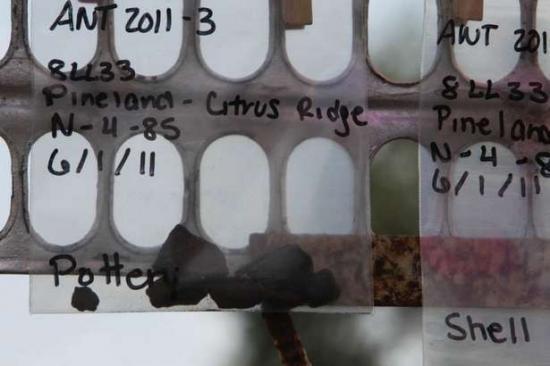Scientists dig for hints of ancient hurricanes
Paleotempestologist leads project on Pine Island site
Sarah Coward
Source - http://www.citizen-times.com/article/A4/20110602/NEWS0105/106020351/Scientists-dig-hints-ancient-hurricanes?odyssey=nav|head
A sea turtle bone protruded from the wall of an archaeological excavation at the Pineland Site Complex on Pine Island.
That bone, along with other evidence found in the pit, might prove that an intense hurricane pounded the island 1,700 years ago, said University of Florida graduate student Melissa Ayvaz, who is conducting the excavation.
"We have evidence from one portion of the site that most likely a storm happened, but we don't know the extent of it," Ayvaz said. "My work is to characterize the extent of the storm and determine if it was one event or multiple events."
American Indians settled at the Pineland site possibly as early as the first century B.C.

By about 800 A.D., the locals had become what archaeologists call a complex society, one that settles in one place, develops social classes, each with a particular function, and builds things.
The dominant society in Southwest Florida when the Spanish arrived in the early 16th century was the Calusa, who built huge mounds and dug navigational canals.
Evidence from small test pits dug in 1992 suggests that the storm surge from one or more hurricanes washed over the Pineland settlement in about the fourth century.

"In 1992, we found deposits of animals like sea turtles, monk seals, dolphins and surf clams, things you wouldn't expect to live in the area by Pineland," said Bill Marquardt, curator in archaeology at the Florida Museum of Natural History in Gainesville. "They were brought in from the Gulf by a powerful storm surge. That's our hypothesis."
According to the hypothesis, people were living on a layer of shell, which they had placed on a ridge near what is now called Pine Island Sound.
When the storm hit, sand carried by wind and storm surge covered the shell mound; sometime after the storm, people returned, put another layer of shell over the storm-generated sand, and took up residence again.
Because large amounts of samples were not collected during the 1992 dig, Ayvaz has started a more extensive excavation to test whether the storm actually occurred and possibly how powerful it was.

In her search for the truth, Ayvaz is pursuing a relatively new discipline called paleotempestology, the study of ancient storms.
Understanding past storms can help scientists understand future storms, said Bruce Bower, a physical scientist in paleoclimatology program at the National Oceanic and Atmospheric Administration.
"We have 100 years of hurricane history, and we know what to expect with respect to hurricane frequency," Bower said. "But a century is a short time in Earth's history. With a longer record, we might discover that hurricane frequency and strength is different from our expectations. In short, maybe what we think is normal isn't."
Ayvaz, who worked for four years at the Florida Museum of Natural History on material from previous Pineland digs, is looking for bones and shells from Gulf animals. The best clues to major storm are articulated (attached) bivalves and bones, which indicate the animals washed in whole on a storm surge and were buried by the sand.
But she's also looking at the world of the very small: Sand grains from Gulf beaches brought to Pineland by wind and water.
Researchers can tell by looking under a microscope whether sand grains were wind- or water-borne. Wind-borne sand grains crash into each other and become crazed (covered with fine cracks).
Volunteers and Ayvaz started digging May 18 and will continue until June 10.
So far, the pit is about 20 inches deep, and Ayvaz wants to go to the water table, another 5 feet.
Slowly and meticulously excavating the pit centimeter by centimeter, documenting bones, shells and grains of sand, Ayvaz knows archaeology is not an Indiana Jones adventure, and that's OK with her.
"I'm a big dork," she said. "I'm very patient. And I'm excited: I spent all that time at the museum looking at pictures of what other people have done, and now I'm continuing the work they did. This work is so tedious, but it prepares the way for other people to work on what I've done."